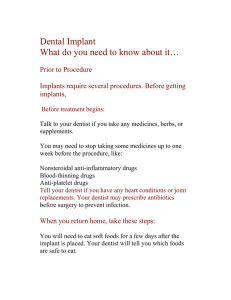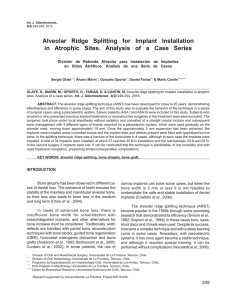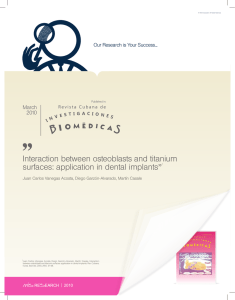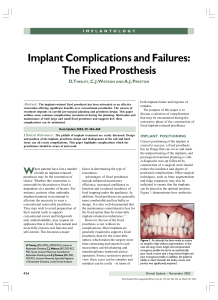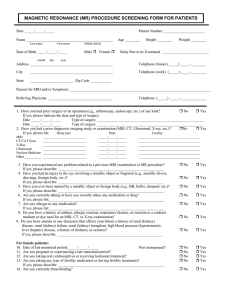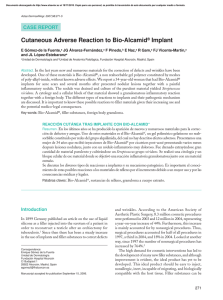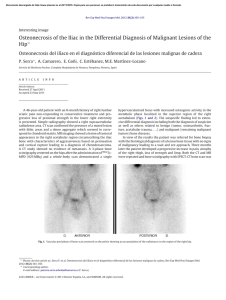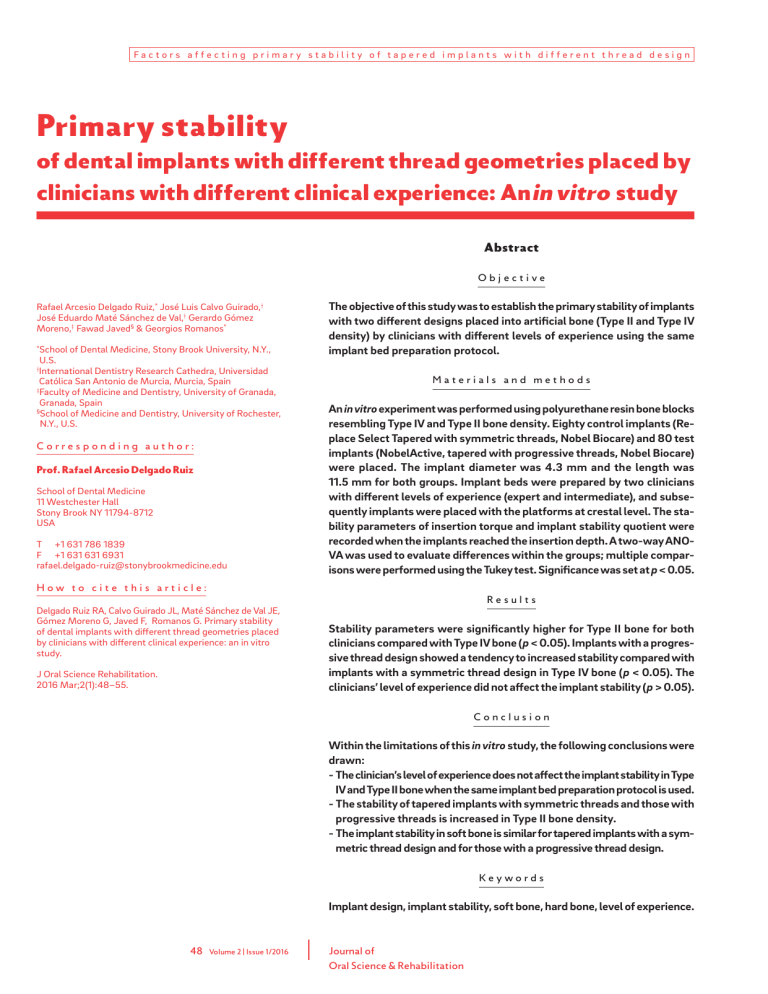
Factors affecting primary stability of tapered implants with different thread design Primary stability of dental implants with different thread geometries placed by clinicians with different clinical experience: An in vitro study Abstract Objective Rafael Arcesio Delgado Ruiz,* José Luis Calvo Guirado,† José Eduardo Maté Sánchez de Val,† Gerardo Gómez Moreno,‡ Fawad Javed§ & Georgios Romanos* School of Dental Medicine, Stony Brook University, N.Y., U.S. † International Dentistry Research Cathedra, Universidad Católica San Antonio de Murcia, Murcia, Spain ‡ Faculty of Medicine and Dentistry, University of Granada, Granada, Spain § School of Medicine and Dentistry, University of Rochester, N.Y., U.S. * Corresponding author: Prof. Rafael Arcesio Delgado Ruiz School of Dental Medicine 11 Westchester Hall Stony Brook NY 11794-8712 USA T +1 631 786 1839 F +1 631 631 6931 rafael.delgado-ruiz@stonybrookmedicine.edu The objective of this study was to establish the primary stability of implants with two different designs placed into artificial bone (Type II and Type IV density) by clinicians with different levels of experience using the same implant bed preparation protocol. Materials and methods An in vitro experiment was performed using polyurethane resin bone blocks resembling Type IV and Type II bone density. Eighty control implants (Replace Select Tapered with symmetric threads, Nobel Biocare) and 80 test implants (NobelActive, tapered with progressive threads, Nobel Biocare) were placed. The implant diameter was 4.3 mm and the length was 11.5 mm for both groups. Implant beds were prepared by two clinicians with different levels of experience (expert and intermediate), and subsequently implants were placed with the platforms at crestal level. The stability parameters of insertion torque and implant stability quotient were recorded when the implants reached the insertion depth. A two-way ANOVA was used to evaluate differences within the groups; multiple comparisons were performed using the Tukey test. Significance was set at p < 0.05. How to cite this article: Delgado Ruiz RA, Calvo Guirado JL, Maté Sánchez de Val JE, Gómez Moreno G, Javed F, Romanos G. Primary stability of dental implants with different thread geometries placed by clinicians with different clinical experience: an in vitro study. J Oral Science Rehabilitation. 2016 Mar;2(1):48–55. Results Stability parameters were significantly higher for Type II bone for both clinicians compared with Type IV bone (p < 0.05). Implants with a progressive thread design showed a tendency to increased stability compared with implants with a symmetric thread design in Type IV bone (p < 0.05). The clinicians’ level of experience did not affect the implant stability (p > 0.05). Conclusion Within the limitations of this in vitro study, the following conclusions were drawn: - The clinician’s level of experience does not affect the implant stability in Type IV and Type II bone when the same implant bed preparation protocol is used. - The stability of tapered implants with symmetric threads and those with progressive threads is increased in Type II bone density. - The implant stability in soft bone is similar for tapered implants with a symmetric thread design and for those with a progressive thread design. Keywords Implant design, implant stability, soft bone, hard bone, level of experience. 48 Volume 2 | Issue 1/2016 Journal of Oral Science & Rehabilitation Factors affecting primary stability of tapered implants with different thread design Introduction Figs. 1a & b Dental implant stability is important for achieving osseointegration. The implant body design and the thread geometry are significant for improvement of the mechanical implant stability. Tapered implants appear to have better mechanical stability than do parallel-walled implants.1 A study comparing the insertion torque of tapered and of cylindrical implants has shown that tapered implants are associated with higher primary stability than are cylindrical implants.2 In an experimental study on dogs, Kim et al. compared the mechanical properties of tapered and parallel-walled implants in terms of success rates.3 Maximum insertion torque and maximum removal torque were assessed. The results showed significantly higher values of maximum insertion torque and maximum removal torque for tapered implants than for parallel-walled implants. In addition, use of cylindrical nonthreaded implants has been associated with a higher implant failure rate compared with threaded implants.4 Moreover, it has been postulated that tapered implants have a better load distribution to surrounding bone by mimicking the natural root form.5 The implant body design and the thread geometry have been compared in a multicenter clinical study with immediate loading protocols. Different implant designs, such as tapered implants with a symmetric thread design (NobelReplace Tapered Groovy), tapered implants with a progressive thread design (NobelActive internal connection), and cylindrical implants with the same thread profile as the NobelActive internal connection but with a narrow neck (NobelActive external connection), presented a similar cumulative survival rate after three years of loading.6 In addition, the bone condensation technique in cancellous bone and other surgical techniques may influence implant stability.7 The quality of the osteotomy might be influenced by the clinician’s surgical experience1, 8 and therefore the primary stability could be Figs. 1a & b a Synthetic bone blocks used in the experiment. (a) Type II dense bone. (b) Type IV soft bone. b affected. There is a lack of studies in the literature evaluating primary stability and its relation to surgical experience. Therefore, the aim of this study was to evaluate the primary stability of two implant designs with different thread geometries placed by two clinicians with different levels of clinical experience in implant surgical procedures and placed into two different bone qualities. Materials & methods Two surgeons with different levels of experience performed the drilling: expert (GR, 25 years’ experience in implant dentistry, had placed more than 10,000 implants) and intermediate (RD, 15 years’ experience in implant dentistry, had placed fewer than 5,000 implants). The implant bed on synthetic bone blocks was prepared for two different implant designs: Replace Select Tapered regular platform (Nobel Biocare, Gothenburg, Sweden), a tapered implant with a symmetric thread design (TST) and conical connection; and Table 1 Table 1 Mechanical properties Block of Type II density Block of Type IV density Compressive yield strength 31.0 MPa 2.30 MPa Compressive modulus 0.759 GPa 0.032 GPa Journal of Oral Science & Rehabilitation Volume 2 | Issue 1/2016 Mechanical properties of the synthetic blocks used in the experiment. 49 Factors affecting primary stability of tapered implants with different thread design Implants placed Group 1 Group 2 Group 3 Group 4 Group 5 Group 6 Group 7 Group 8 n = 40 n = 40 n = 40 n = 40 n = 40 n = 40 n = 40 n = 40 N = 320 a b c d e f g h ISQ value (mean ± S.D.) 63 ± 4e, f, g, h 63 ± 3e, f, g, h 65 ± 3e, f, g, h 65 ± 5e, f, g, h 54 ± 3 59 ± 2e, g 53 ± 2 58 ± 1e, g Implants placed Group 1 Group 2 Group 3 Group 4 Group 5 Group 6 Group 7 Group 8 n = 40 n = 40 n = 40 n = 40 n = 40 n = 40 n = 40 n = 40 N = 320 a b c d e f g h IT value (mean ± S.D. in N cm) 40 ± 2e, f, g, h Table 2 Differences in primary stability were observed between different bone densities and between different implant designs in terms of ISQ. The Tukey multiple comparison test showed differences favoring higher stability in Type II bone density compared with Type IV. Regarding implant design, implants with a progressive thread design in Type IV bone density favored higher stability. There were no differences in implant stability regarding level of experience. Table 3 Differences in primary stability were observed between different bone densities in terms of IT. The Tukey multiple comparison test showed differences favoring higher stability in Type II bone density compared with Type IV. Regarding implant design and level of experience, there were no differences in implant stability. 42 ± 4e, f, g, h 41 ± 5e, f, g, h 43 ± 2e, f, g, h 18 ± 2 NobelActive regular platform (Nobel Biocare), a tapered implant with a progressive thread design (TPT) and conical connection. The implant diameter of 4.3 mm and length of 11.5 mm were used for all groups. For this experimental controlled study, two synthetic bone blocks (Sawbones, Pacific Research Laboratories, Vashon Island, Wash., U.S.) measuring 13 cm × 18 cm × 4 cm, with two different densities (Type II and Type IV), were used (Figs. 1a & b). The Type II solid block was of 0.85 ± 0.4 g/cm3 in density and the Type IV cellular block was of 0.45 ± 0.10 g/cm3 in density. The mechanical properties of the artificial blocks used in the study are presented in Table 1. 20 ± 1 17 ± 2 19 ± 1 Drilling procedures The blocks were fixed to a metallic platform to reduce movement during drilling, as well as to ensure the same experimental conditions for both operators. The drilling protocol used was recommended by the manufacturer and was performed by a calibrated operator. Instructions were provided to both clinicians regarding the manner in which they were to prepare the implant bed. During drilling, an in-and-out motion and drilling in the bone for 1–2 s without stopping the handpiece motor were performed until the drill reached the depth reference line (11.5 mm). The drilling parameters were the same for both operators: drilling speed of 800 rpm with no irrigaEight experimental groups were created as follows: tion, and the drills were replaced after ten uses Group 1: Expert + Type II blocks + TST as recommended by the manufacturer. Group 2: Expert + Type II blocks + TPT Group 3: Intermediate + Type II blocks + TST – Drilling for the Replace Select Tapered implant Group 4: Intermediate + Type II blocks + TPT in Type II and Type IV bone: The drilling started Group 5: Expert + Type IV blocks + TST with the 2.0 mm diameter pilot drill, followed Group 6: Expert + Type IV blocks + TPT by the 3.5 mm diameter tapered drill and Group 7: Intermediate + Type IV blocks + TST finished with the 4.3 mm tapered drill. Group 8: Intermediate + Type IV blocks + TPT. – Drilling for the NobelActive implant in Type IV bone (soft-bone protocol): The drilling started A total of 320 perforations were performed, 160 with the 2.0 mm diameter drill, followed by a perforations on each block. The allocation of stepped drill with 2.4/2.8 mm diameter steps samples to groups was performed according to and finished with a stepped drill with 2.8/3.2 randomization software (Research Randomizer),9 mm diameter steps. and after the allocation each one of the eight – Drilling for the NobelActive implant in Type II groups was composed of 40 samples (Fig. 2). bone (hard-bone protocol): The drilling started 50 Volume 2 | Issue 1/2016 Journal of Oral Science & Rehabilitation Table 2 Table 3 Factors affecting primary stability of tapered implants with different thread design Fig. 2 with the 2.0 mm diameter drill, followed by The implants were then retrieved and placed into a stepped drill with 2.4/2.8 mm diameter steps the hard bone for the evaluation of primary staand finished with a stepped drill with 3.2/3.6 mm bility. A total of 320 evaluations were performed. diameter steps. Primary stability evaluation Fig. 2 Study design scheme for the 320 implant beds prepared in synthetic bone blocks with different bone densities. Implant characteristics – Replace Select Tapered: This implant possesses a conical profile with the same thread profile. The body is tapered, the neck has micro-threads and the connection is conical (Fig. 3b). – NobelActive: This implant possesses a variable-thread profile, wider (vertically) and shorter (horizontally) as it progresses from the neck area, in which there are micro-threads. In the apical region, the implant has a pronounced tapered body with sharp threads to facilitate insertion and cutting of unprepared bone. The connection is conical and the coronal region is back-tapered coronally, which results in a reduction of the platform diameter (Fig. 3a). Implant placement A total of 160 implants were placed in a random scheme in 320 implant bed preparations, until they reached the crestal level, leaving the implant platforms flush with the block surface (Fig. 4). The implants were placed first into the soft bone and primary stability was evaluated afterwards. The evaluation of primary stability was performed according to the insertion torque (IT) and the implant stability quotient (ISQ) as follows: - IT was measured during implant insertion by the implant motor (DENTSPLY, Waltham, Mass., U.S.) and was recorded in N cm. The peak values were reached when the implant platform was located at the surface of the bone block (11.5 mm). Each placed implant resulted in a single value, and mean values were collated by group and compared. - ISQ was recorded using resonance frequency analysis with the Osstell Mentor device (Osstell, Göteborg, Sweden). Specific transducers were used, and replaced after ten uses until all of the measurements had been performed. Measurements were taken as follows: The transducer was screwed to the placed implant. The probe was laterally oriented in relation to the transducer and measurements were taken. Each measurement was repeated in triplicate and mean values were recorded. All measurements were performed by an independent, Journal of Oral Science & Rehabilitation Volume 2 | Issue 1/2016 51 Factors affecting primary stability of tapered implants with different thread design Figs. 3a & b Fig. 3 Implant designs used for the implant stability evaluation. (a) Tapered implant with a symmetric thread design. (b) Tapered implant with a progressive thread design. a b unbiased examiner. Data were expressed as the tapered implants with a progressive thread ISQ values (1–100). Mean values were collated design had increased primary stability in soft by group and compared. bone compared with the tapered implants with a symmetric thread design for different evaluation groups (Groups 5, 6, 7 and 8; p < 0.05). HowStatistical analysis ever, within the dense bone groups, no significant The statistical analyses were performed with differences in terms of stability were found for SPSS software (Version 13.0; SPSS, Chicago, Ill., the two implant thread designs (Groups 1, 2, 3 U.S.). For the evaluation of the normality distri- and 4; p > 0.05). The evaluation by IT values did butions of each group, the Shapiro–Wilk test was not show differences in stability in soft bone used. A two-way ANOVA was used to evaluate (p > 0.05; Tables 2 & 3). differences within groups and the impact of the Regarding the effects of the operator’s level operator on the stability parameters. Multiple of experience on the implant stability, no statiscomparisons were performed using the Tukey tically significant differences were observed test. Significance was set at p < 0.05. Data were between the implant groups in IT or ISQ values expressed as mean value ± S.D. and ranges were (p > 0.05; Tables 2 & 3). calculated for each group. Results All of the implants were mechanically stable, but implant stability differed between groups. Regarding bone density, the results showed higher stability (p < 0.05) evaluated by ISQ in dense bone (Groups 1, 2, 3 and 4) compared with soft bone (Groups 5, 6, 7 and 8). Regarding the effects of the implant design, the results showed that 52 Volume 2 | Issue 1/2016 Discussion Some authors consider that the implant survival rate is higher for experienced clinicians,10–13 while others have found similar cumulative implant survival rates independent of the clinicians’ level of experience.14, 15 However, there is a lack of research in the literature regarding the effect of level of experience on primary stability; therefore, the present Journal of Oral Science & Rehabilitation Factors affecting primary stability of tapered implants with different thread design Fig. 4 Fig. 4 Implant insertion level for the evaluation of the IT and the ISQ values. The implants were placed with the most coronal portion of the platform flush with the block surface. in vitro study compared the primary stability of implant designs with symmetric or progressive threads in soft and hard bone placed by clinicians with different levels of surgical experience. There is great variability in the definition of level of experience used in previous studies. Lambert et al. regarded an experienced clinician as one who had placed more than 50 implants and an inexperienced one as having placed fewer than 50 implants.13 Preiskel and Tsolka considered experienced clinicians those periodontists and oral and maxillofacial surgeons with more than two years of experience with dental implants and they considered as inexperienced those oral and maxillofacial surgeons just beginning their involvement in dental implants.16 Hinckfuss et al. classified level of experience as novice (dental students with no clinical surgical implant experience who had completed an instructional laboratory course in placing implants in typodonts), intermediate (graduate periodontology residents who had placed between 20 and 80 implants clinically) and experienced (periodontists who had placed over 300 implants clinically).17 The present experimental study assigned to the surgeons two levels of experience: expert (25 years’ experience in implant dentistry and more than 10,000 implants placed) and intermediate (15 years’ experience in implant dentistry and fewer than 5,000 implants placed). Compared with other studies, this is one of the strictest measurements of clinician experience. The rationale is based on a study in psychology that demonstrated that level of experience is determined, among others, by learning (skills acquired through repetition) and performance (quality of the procedures that is dependent on the performer);18 therefore, it can be asserted that the number of years of experience and the number of procedures performed used in the present experiment are reasonable. The results of the present work showed that the effects of the thread design were beneficial for primary stability, especially in the soft bone, as measured by ISQ value and that there was no Journal of Oral Science & Rehabilitation Volume 2 | Issue 1/2016 53 Factors affecting primary stability of tapered implants with different thread design significance in the final implant stability regarding the two clinicians’ levels of experience for both bone qualities (soft and hard bone) and the two implant designs. The IT values were not conclusive for differences between implant design and primary stability. Apparently, the sensitivity of the ISQ meter is able to detect very small differences,19 while IT underestimates the stability values. The motor used for the evaluation of IT in this experimental study operates in increments of 5 N cm; therefore, values below 5 N cm can be underestimated. However, the implants used had a tapered shape and this may be the main reason that the stability of the implants was similar (p > 0.05). Previous studies have shown that implants with symmetric threads and a cylindrical or tapered implant body shape have different primary stability when they are placed in soft bone (parallel-walled implants have lower stability) and the clinician’s level of experience appears to be important.1, 8 The data in this study confirm that the tapered implant design used (Replace Select Tapered and NobelActive) may achieve excellent stability for clinicians with different levels of experience in an experimental set. A recent study comparing the survival rates of dental implants placed in a residency program under direct supervision for the treatment of patients with overdentures has shown a high survival rate of 97.7% within a period of two years.20 The researchers concluded that novice general dentistry residents can successfully place mandibular implants and restore them with overdentures under direct supervision, resulting in subsequent enhancement of the patients’ satisfaction with their mandibular dentures. However, new clinical trials by a national group of dental practitioners presented higher failure rates for implants placed by general dentists compared with those for implants placed by clinicians with specialty training.21 For other studies, experience was defined as number of implants placed, and clinical studies showed that those clinicians (n = 1,260) with experience of placing fewer than 50 implants presented a higher failure rate of 3.5%, compared with surgeons (n = 1,381) with greater surgical experience (50 or more implants), who showed a failure rate of 1.8%.13 There is no doubt that primary stability of dental implants is of significant importance for achieving long-term success, especially when implants are loaded immediately after place- 54 Volume 2 | Issue 1/2016 ment.22 The mechanical stability of the implant is very important, particularly in soft bone, and the thread design may provide better mechanical anchorage in the surrounding bone. A previous study evaluating implant stability based on the thread pitch width showed that implants with a narrow thread pitch had a higher stability owing to the greater surface area, compared with implants with a wider thread pitch when they were placed in cancellous bone.23 Conclusion Within the limitations of this in vitro study, the following conclusions can be drawn: - The operator’s level of experience, expert versus intermediate, does not affect the implant stability in Type IV and Type II bone when the same implant bed preparation protocol is used. - The stability of tapered implants with symmetric threads and those with progressive threads is increased in Type II bone density. - The implant stability in soft bone is similar for tapered implants with a symmetric thread design and for those with a progressive thread design. Competing interests The authors declare that they have no competing interests related to this study. No financial support was received for this study. Journal of Oral Science & Rehabilitation Factors affecting primary stability of tapered implants with different thread design References 1. Romanos GE, Ciornei G, Jucan A, Malmstrom H, Gupta B. In vitro assessment of primary stability of Straumann implant designs. → Clin Implant Dent Relat Res. 2014 Feb;16(1):89–95. 2. O’Sullivan D, Sennerby L, Meredith N. Measurements comparing the initial stability of five designs of dental implants: a human cadaver study. → Clin Implant Dent Relat Res. 2000 Apr;2(2):85–92. 3. Kim JW, Baek SH, Kim TW, Chang YI. Comparison of stability between cylindrical and conical type mini-implants: mechanical and histologic properties. → Angle Orthod. 2008 Jul;78(4):692–8. 4. Chrcanovic BR, Albrektsson T, Wennerberg A. Reasons for failures of oral implants. → J Oral Rehabil. 2014 Jun;41(6):443–76. 5. Maiorana C, Santoro F. Maxillary and mandibular bone reconstruction with hip grafts and implants using Frialit-2 implants. → Int J Periodontics Restorative Dent. 2002 May-Jun;22(3):221–9. 6. Arnhart C, Kielbassa AM, Martinez-de Fuentes R, Goldstein M, Jackowski J, Lorenzoni M, Maiorana C, Mericske-Stern R, Pozzi A, Rompen E, Sanz M, Strub JR. Comparison of variable-thread tapered implant designs to a standard tapered implant design after immediate loading. A 3-year multicentre randomised controlled trial. → Eur J Oral Implantol. 2012 Aug;5(2):123–36. 7. Marković A, Ćalasan D, Čolić S, Stojčev-Stajčić L, Janjić B, Mišić T. Implant stability in posterior maxilla: bone-condensing versus bone-drilling: a clinical study. → Oral Surg Oral Med Oral Pathol Oral Radiol Endod. 2011 Nov;112(5):557–63. 12. Melo MD, Shafie H, Obeid G. Implant survival rates for oral and maxillofacial surgery residents: a retrospective clinical review with analysis of resident level of training on implant survival. → J Oral Maxillofac Surg. 2006 Aug;64(8):1185–9. 8. Romanos GE, Basha-Hijazi A, Gupta B, Ren YF, Malmstrom H. Role of clinician’s experience and implant design on implant stability. An ex vivo study in artificial soft bones. → Clin Implant Dent Relat Res. 2014 Apr;16(2):166–71. 13. Lambert P, Morris H, Ochi S. Positive effect of surgical experience with implants on second-stage implant survival. → J Oral Maxillofac Surg. 1997 Dec;55(12):12–8. 9. Urbaniak GC, Plous S. Research Randomizer [Internet-based computer software]. Version 4.0. [cited 2013 Dec 18]. 2013. → Available from: http://www.randomizer.org/. 10. Moraschini V, Velloso G, Luz D, Porto Barboza E. Implant survival rates, marginal bone level changes, and complications in full-mouth rehabilitation with flapless computer-guided surgery: a systematic review and meta-analysis. → Int J Oral Maxillofac Surg. 2015 Jul;44(7):892–901. 11. Geckili O, Bilhan H, Geckili E, Cilingir A, Mumcu E, Bural C. Evaluation of possible prognostic factors for the success, survival, and failure of dental implants. → Implant Dent. 2014 Feb;23(1):44–50. 14. Minsk L, Polson AM, Weisgold A, Rose LF, Sanavi F, Baumgarten H, Listgarten MA. Outcome failures of endosseous implants from a clinical training center. → Compend Contin Educ Dent. 1996 Sep;17(9):848–50, 852–4, 856 passim. 15. Zupnik J, Kim S, Ravens D, Karimbux N, Guze K. Factors associated with dental implant survival: a 4-year retrospective analysis. → J Periodontol. 2011 Oct;82(10):1390–5. 16. Preiskel HW, Tsolka P. Treatment outcomes in implant therapy: the influence of surgical and prosthodontic experience. → Int J Prosthodont. 1995 May-Jun;8(3):273–9. 17. Hinckfuss S, Conrad HJ, Lin L, Lunos S, Seong W. Effect of surgical guide design and surgeon’s experience on the accuracy of implant placement. → J Oral Implantol. 2012 Aug;38(4):311–23. 19. Turkyilmaz I, Company AM. Sensitivity of resonance frequency analysis method to assess implant stability. → N Y State Dent J. 2011 Aug-Sep;77(5):44–9. 20. Malmstrom H, Xiao J, Romanos GE, Ren YF. Training needs for general dentistry residents to place and restore two-implant-retained mandibular overdentures. → J Dent Educ. 2015 Jan;79(1):72–80. 21. Da Silva JD, Kazimiroff J, Papas A, Curro FA, Thompson VP, Vena DA, Wu H, Collie D, Craig RG. Outcomes of implants and restorations placed in general dental practices: a retrospective study by the Practitioners Engaged in Applied Research and Learning (PEARL) Network. → J Am Dent Assoc. 2014 Jul;145(7):704–13. 22. Javed F, Romanos GE. The role of primary stability for successful immediate loading of dental implants. A literature review. → J Dent. 2010 Aug;38(8):612–20. 23. Orsini E, Giavaresi G, Trirè A, Ottani V, Salgarello S. Dental implant thread pitch and its influence on the osseointegration process: an in vivo comparison study. → Int J Oral Maxillofac Implants. 2012 Mar-Apr;27(2):383–92. 18. Ritter FE, Schooler LJ. The learning curve. → In: Smelser NJ, Baltes PB, editors. International encyclopedia of the social and behavioral sciences. Amsterdam: Pergamon Press; 2001. p. 8602–5. Journal of Oral Science & Rehabilitation Volume 2 | Issue 1/2016 55
